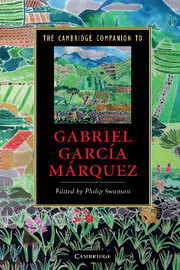Book contents
- Frontmatter
- Introduction
- 1 Gabriel García Márquez: life and times
- 2 The critical reception of García Márquez
- 3 Before One Hundred Years of Solitude: the early novels
- 4 One Hundred Years of Solitude
- 5 An eco-critical reading of One Hundred Years of Solitude
- 6 The Autumn of the Patriarch
- 7 The General in His Labyrinth
- 8 García Márquez’s novels of love
- 9 García Márquez’s short stories
- 10 García Márquez’s non-fiction works
- 11 García Márquez and film
- 12 García Márquez, magical realism and world literature
- Further reading
- Index
4 - One Hundred Years of Solitude
Published online by Cambridge University Press: 28 September 2010
- Frontmatter
- Introduction
- 1 Gabriel García Márquez: life and times
- 2 The critical reception of García Márquez
- 3 Before One Hundred Years of Solitude: the early novels
- 4 One Hundred Years of Solitude
- 5 An eco-critical reading of One Hundred Years of Solitude
- 6 The Autumn of the Patriarch
- 7 The General in His Labyrinth
- 8 García Márquez’s novels of love
- 9 García Márquez’s short stories
- 10 García Márquez’s non-fiction works
- 11 García Márquez and film
- 12 García Márquez, magical realism and world literature
- Further reading
- Index
Summary
The publication of One Hundred Years of Solitude (Cien años de soledad) in Buenos Aires in May 1967 represented, according to the great Latin American writer and critic Mario Vargas Llosa, 'a literary earthquake'. Literariness is a sensitive notion in the criticism of Latin American fiction and is often subordinated to issues of the political impact of texts - be it at the level of authorial stance, interpretation of content or the context of reception and consumption. Yet the literary nature of García Márquez's great work is not a topic that can or should be avoided. Critics who are more consciously politically motivated may feel uncomfortable if we begin with the rather obvious assertion, then, that One Hundred Years of Solitude is a work of fiction. The rise of the Latin American New Novel from, roughly, the 1940s and 1950s onwards and its culmination in the so-called Boom of the 1960s was associated in the minds of many observers with a reaction against traditional realism based on an assumption that reality was observable, understandable and translatable into literature. Equally, many would regard 1967 and the appearance of One Hundred Years of Solitude as the culmination of that process. The novel opens with José Arcadio Buendía, the founding father of Macondo (the imaginary town in which much of the narrative is set), inviting his offspring to read with their imaginations rather than in relation to their knowledge of reality: in a room plastered with unrealistic maps and fabulous drawings, he teaches them to read by telling them of 'the wonders of the world' ('las maravillas del mundo') and 'forcing the limits of his or their imagination to extremes'.
- Type
- Chapter
- Information
- The Cambridge Companion to Gabriel García Márquez , pp. 57 - 63Publisher: Cambridge University PressPrint publication year: 2010
- 2
- Cited by

